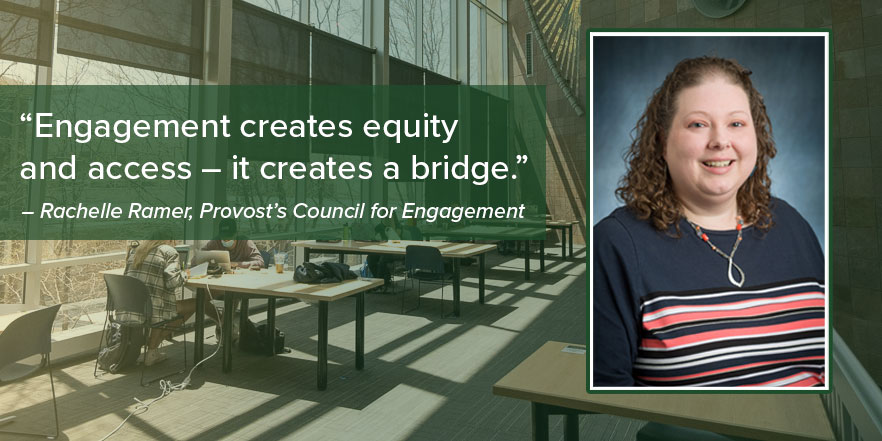Provost’s Council for Engagement Spotlight: Rachelle Ramer


As part of CSU’s land-grant mission, the Provost’s Council for Engagement serves to integrate academic scholarship and community engagement. The Continuum of Engaged Scholarship highlights the what, why, and how of engagement, conducted across the university’s mission areas.
Members of the Provost’s Council bring unique perspectives and experience to community-engaged scholarship and research. In this series, we spotlight individual members, highlighting their work and impact across Colorado.
Q&A Spotlight: Rachelle Ramer, MLIS
Rachelle Ramer is the Graduate Student Success and Inclusion Librarian in CSU Libraries’ newly created Research Support Unit. Her passion is supporting students as they transition from undergraduate-level researcher to that expected of graduate students.
“Well, I think it’s not just important, it’s absolutely critical, especially as a land grant institution with our principles of community, our mission and values. Without engagement, I believe we would be failing all of that.
Without engagement it is too easy to stay in our silos – and not be aware of what is going on around us – we are not listening. And we have both internal and external engagement. Internally, are we including all the voices? Respect and communication are key.”
“When I when I think about engagement as a librarian, what I am reflecting on is: what does engaged librarianship look like? I think of what we call ‘critical librarianship,’ which is an acknowledgement that information systems aren’t neutral. Choices are made about what is recorded, what is saved; some voices are excluded or misrepresented. Without that deliberate effort to seek out those voices, we will only hear the usual voices. Who gets published? Who can afford to access those publications?
We talk about the ‘scholarly conversation,’ largely supported by these publications. Going back to the beginning of some of these scholarly publications, the conversation between these academics and researchers was through these letters, and then the format became standardized, which became these publications. But if you are not in that conversation – published in these curated journals – your voice is not being heard.
It took decades of trying, of attempts at publication and presentations, before Vera Rubin’s work on dark matter was listened to by the scientific community. You will also see that these journals are outrageously expensive – so people may be unable to publish, but they also cannot afford to access the publications to learn about recent research. This is a real barrier. Engagement creates equity and access – it creates a bridge.”
“I help students and faculty find alternate voices and sources of information. By teaching my students to think critically about the process, the costs, the construction of authority, that I am helping them find better sources and, taking a critical view of information and its sources, they learn to ask better questions for their research. I also try to help my students recognize their place in the scholarly conversation – recognize that they have a voice, that they are in the process of constructing their own authority. And that means they have power and responsibility in the knowledge they create and in how they engage with both academia and their communities.”
“I joined because it is an opportunity to support the highest quality teaching and research at CSU. I also think that the recognition for those doing this work is so important. If we see it more we will value and emulate it more.
Although I switched careers to librarianship, at heart I am still a scientist. All the evidence I see shows that open and engaged science is the fastest way for us all to move forward, while preserving the importance of concepts like reproducibility. Engaged science asks bigger, more complex questions. My hope for the Council is that we continue to grow the awareness and celebration of engaged research and teaching at CSU.”